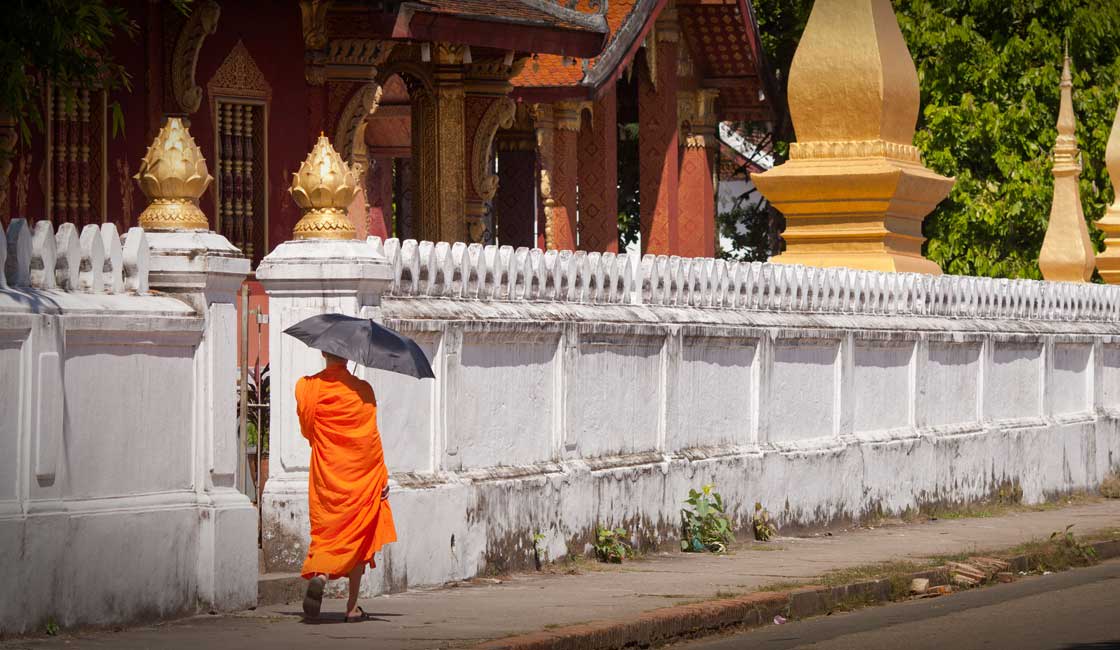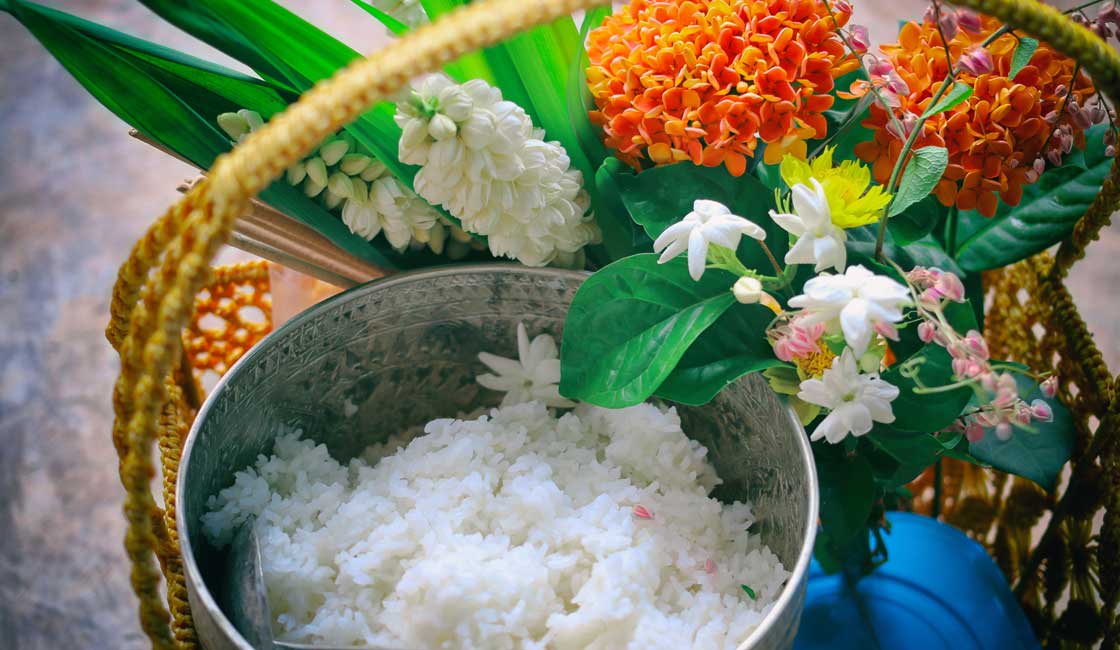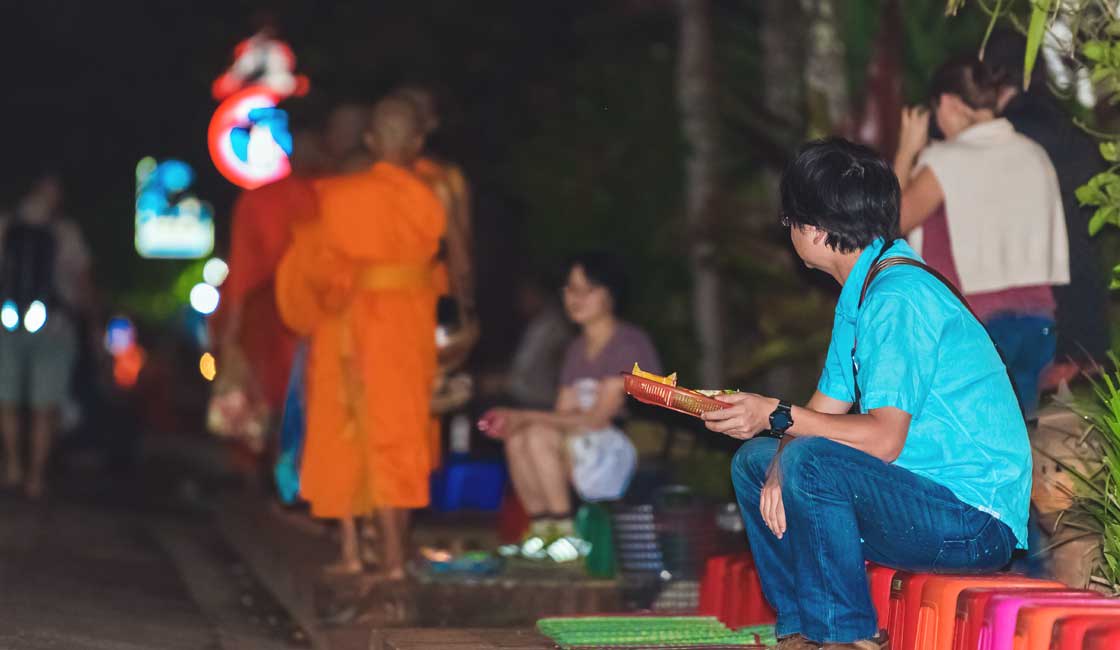
There’s something very special about places where two rivers meet. The mingling of waters has always been celebrated historically, perceived as sacred and spiritual. This is very much the case in Laos’s best-preserved historic town, and former capital – Luang Prabang. Situated in the north of Laos, surrounded by mountainous landscapes on the confluence of the Nam Khan River and the Mekong, time stands still in this sleepy but spellbinding place.
Luang Prabang is full of charm and offers a unique window into Laos’ fascinating past. Meander through the town’s winding streets, taste its Lao cuisine and experience its one-of-a-kind culture, an amazing fusion of European and Southeast Asian traditions.
Every morning, something extraordinary occurs. If you wake up before dawn and head out onto the streets, you’ll witness a piece of history taking place before your eyes, as saffron-clad Buddhist monks pad out silently into the streets in semi-darkness – the Tak Bat alms giving ceremony.

Monks are common in the streets of Luang Prabang
There’s little doubt that this town has experienced a recent surge of development – there are brand new boutique hotels that have recently been restored, and evidence of a swelling population in the villages that surround the old town. However, the magical town of Luang Prabang has managed to remain unique, well-kept, and one of Southeast Asia’s hidden gems.
Translating directly as ‘city of the Golden Buddha Phra Bang’, Buddhism has long been at the core of the lives of generations of people who call this their home. The Phra Bang itself is a fairly small (only 83cm / 33 inches tall) statue of the Buddha, cast in gold, that is an incredibly significant artifact in the town’s history and culture. Today, it is sheltered on the grounds of Luang Prabang Royal Palace, in an ornate temple called Haw Pha Bang.
This enchanting town in northern Laos is now a UNESCO World Heritage Site because of its exceptional preservation of cultural, religious, and architectural heritage. Some of the region’s most exquisite Buddhist temples and monasteries exist here. Stepping foot in its streets is a strange feeling, as it’s almost like being transported somewhere in Europe. This is because of its French colonial past, whose mark is stamped on the town’s architecture and culture.

Alms giving is an important part of Lao people
One of the cultural traditions that have remained unchanged throughout the town’s shifting history is the daily alms giving ceremony – called Tak Bat, or sometimes Sai Bat. It is an ancient tradition in Laos Buddhist culture, occurring every day with the sunrise. Hundreds of Buddhist monks appear and walk down the roads of Luang Prabang to get their daily sustenance. It takes place throughout the whole of the country, but Luang Prabang is one of the best places to experience this special event.
But what is it all about? For the monks, this not just a practical trip for food. The procession of around 200 Buddhist monks through the streets to collect food from the laypeople is much more – it is a spiritual action, a silent ritual, sacred and meaningful for both the monks that receive alms and the locals who are offering food.
The monks collect alms as a way to keep their vows, while the locals give alms in order to practice their Buddhist faith. It is not the same as the Westernized notion of charity. Buddhists give alms to gain merit for the afterlife – it is considered the first step on the road to Nirvana.
It is also quite a spectacle. As the morning mist gradually clears, the monks leave their temples brightly dressed in vibrant saffron-colored robes, barefoot, and form lines. They then proceed through the streets, starting in the main street before spiraling out into the little side streets of Luang Prabang. As they progress through the town, Buddhist locals who have woken early to prepare dishes, sit by the roadside and drop food (normally spoonfuls of sticky rice, but sometimes fresh fruit or sweets) into their alms bowls.
This longstanding tradition in Laos is done in complete silence. The monks have taken a vow of silence, and walk-in meditation. It is considered highly ignorant to interrupt their progress through the streets, so the locals respect them and sit in silence too.
Unfortunately, as this remarkable human phenomenon has become increasingly popular on the tourist trail, nowadays this rule of silence is not adhered to. Crowds of travelers tend to get far too close to the monks, and chatter noisily, snapping photographs and spoiling the quiet ceremony. The monks, who depend on these offerings for their daily food, are subjected to a horde of people, camera flashes, and noise.
This alms-giving ceremony is a tradition that dates back to the early 14th century when Theravada Buddhism was first introduced to and adopted by the town of Luang Prabang. However, the town is considered symbolically important for all Buddhists for its religious history and numerous Buddhist temples.
During the hundreds of years since Buddhism was introduced to Laos, this tradition has been an important part of the relationship between the monks and the local townspeople. The monks need these offerings – it is their only food for the entire day. The locals need to give alms in order to achieve spiritual redemption – according to Buddhism, the more you give away, the “wealthier” you become. By giving generously to the monks, they learn the importance of being less materialistic in their day-to-day lives, of serving their community, and being generally more humble.

Rice is important in the ceremony
The locals prepare sticky rice for the monks, which takes a lot of preparation as the rice needs to be rinsed and prepared the day before, and the alms-givers must get up very early to have the rice cooked and ready. The monks themselves have also risen early for their morning meditation. There are about eighty temples in Luang Prabang which amount to around 200 monks.
The monks carry a big lidded bowl hanging by a strap over their shoulders, and the yellow and orange robes that they wear are a reminder of the clothes worn by the Supreme Buddha nearly 2,500 years ago. The devout locals are dressed respectfully, with their shoulders, chests, and legs covered, and they kneel or stand at the side of the road. As the monks file past, they reverently drop the food into their bowls.
Most tourists watch the ceremony from the main streets of Th Sakkarin or Th Kamal, and as a result, these can get noisy and overcrowded. For a more authentic experience, it’s advisable to head to the little side streets between these areas as they are much quieter and more peaceful.

Daily sight in Luang Prabang
The Tak Bat alms giving ceremony is not timetabled, and so there is no set time. It takes place every day all year-round, at sunrise. Dawn is around 5.30 am in the summer, and about 6.30 am in the winter, but it’s a good idea to get to your chosen spot early – well away from the almsgivers and out of the path of the monks.
The sacred daily ritual of giving and receiving alms is an important symbol of the symbiotic and close relationship between the locals and the Buddhist monks. It’s not just a case of giving the monks food – it benefits both sides and is a deeply spiritual ritual.
However, there are many non-Buddhist people visiting Luang Prabang that choose to participate in the actual act of giving alms. This is often facilitated by many of the hotels and guesthouses, who often provide the food, bowls, and spoons for tourists to use.
Should you participate in the alms giving ceremony? This doesn’t have a straightforward answer. As tourists, we are essentially spectators of the many wonderful corners of the world, on the outside looking in. There are things that we can join in with, but when it comes down to it, we will never share or fully understand the profound significance of these traditions.
For non-Buddhists, this is a complex decision, as by taking part you are participating in a religious ceremony that you do not believe in. There are people who believe that by offering alms alongside the locals, you might be belittling their beliefs.
If you decide not to participate, then you can still experience the peace and tranquility of this meditative scene by watching from the sidelines – just make sure you follow these rules for proper tourist etiquette at this sacred event.

After the deed
Tragically, there are rumors that this ancient tradition might not go on forever – the increasing numbers of insensitive people that do not properly respect the tradition means that it is now under threat of disappearance. Today, fewer locals take part as they feel offended by the spectacle it has become and the unruly tourists that get too close and jostle the monks.
Although most people mean well and show a healthy interest in a foreign culture, certain actions are threatening to ruin this incredible place forever. This is not a cultural show, it is a religious ceremony. In order to keep the Tak Bat ceremony healthy and thriving, have a look at the following guidelines:
Whether you’re participating in the alms-giving or not, here are some tips to get the most out of your trip to Luang Prabang.
Laos is visited on all Upper Mekong River cruises and the Tak Bat Morning Alms Giving Ceremony can be visited as part of a custom land tour extension carefully designed to your needs. If you have any queries about visiting Laos with our cruises and land tours, please contact our sales team. We have specific travel specialists in Asia for all of your travel needs. Enquire today to see where we can take you.
While Rainforest Cruises aim to provide accurate and up-to-date information, we make no representations as to the accuracy or completeness of any information herein or found by following any link on this site. Rainforest Cruises cannot and will not accept responsibility for any omissions or inaccuracies, or for any consequences arising therefrom, including any losses, injuries, or damages resulting from the display or use of this information.




